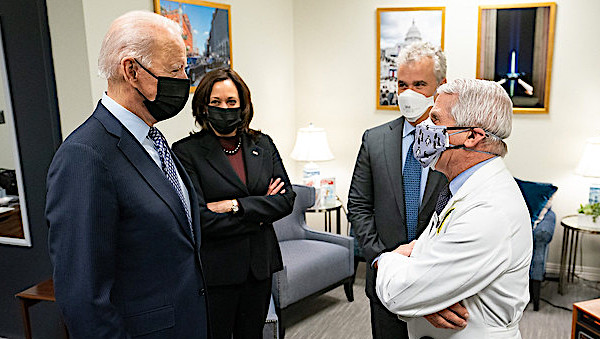
Steven Quay, who holds both a master's and a doctorate degree from the University of Michigan, and Richard Muller, emeritus professor of physics at the University of California, Berkeley, wrote in an op-ed published by the Wall Street Journal on Sunday, June 6, that there are two factors strongly suggesting a lab origin of the outbreak that has infected more than 174 million people worldwide.
"The presence of the double CGG sequence is strong evidence of gene splicing, and the absence of diversity in the public outbreak suggests gain-of-function acceleration. The scientific evidence points to the conclusion that the virus was developed in a laboratory," the pair wrote.
Gain-of-function researchers' sequence of choice appears in SARS-CoV-2
In gain-of-function research, a microbiologist can increase the lethality of a coronavirus enormously by splicing a special sequence into its genome at a prime location. This leaves no trace of manipulation but alters the virus spike protein, rendering it easier for the virus to inject genetic material into the victim cell.
According to the pair, there have been at least 11 separate experiments adding a special sequence to the same location since 1992. The end result has always been supercharged viruses.
A genome is a blueprint for the factory of a cell to make proteins. The language is made up of three-letter "words" that represent the 20 different amino acids.
Quay and Muller noted that in the entire class of coronaviruses that includes SARS-CoV-2, the virus that causes COVID-19, the CGG-CGG combination has never been found naturally.
But in laboratory works, the insertion sequence of choice is the double CGG. It is readily available and convenient, and scientists have a great deal of experience inserting it. The double CGG sequence also creates a useful beacon that permits the scientists to track the insertion in the laboratory.
The double CGG sequence is the exact sequence that appears in SARS-CoV-2 virus.
"Proponents of zoonotic origin must explain why the novel coronavirus, when it mutated or recombined, happened to pick its least favorite combination, the double CGG. Why did it replicate the choice the lab's gain-of-function researchers would have made?" the pair wrote, referring to those who believe that the virus jumped from animal to human.
"At the minimum, this fact – that the coronavirus, with all its random possibilities, took the rare and unnatural combination used by human researchers – implies that the leading theory for the origin of the coronavirus must be laboratory escape."
Lack of genetic diversity points to SARS-CoV-2's gain-of-function origin
The difference in the genetic diversity of SARS-CoV-2 compared with the coronaviruses responsible for Severe Acute Respiratory Syndrome (SARS) and Middle East Respiratory Syndrome (MERS) is another scientific evidence that points to SARS-CoV-2's gain-of-function origin.
Both SARS and MERS were confirmed to have a natural origin – the viruses evolved as they spread through the human population until the most contagious forms dominated.
On the other hand, COVID-19 appeared in humans already adapted into an extremely contagious version. No serious viral improvement took place until a minor variation occurred many months later in England.
Quay and Muller said such early optimization is unprecedented, and it suggests a long period of adaptation that predated its public spread.
"Science knows of only one way that could be achieved and that is through simulated natural evolution, growing the virus on human cells until the optimum is achieved," they wrote. "That is precisely what is done in gain-of-function research."
Scientists now speaking up about possibility of lab-leak theory
The lab-leak theory has attracted fresh attention after President Joe Biden asked the national intelligence community to take a closer look at the possibility. So far, the pieces of evidence are mostly circumstantial.
Days before Biden was sworn in, the Department of State issued a fact sheet saying that several researchers at WIV had fallen ill with COVID-like symptoms before the first publicly known case. It also said that the institute had worked secretly with the Chinese military. (Related: New book details Dr. Fauci's involvement in Wuhan and the Chinese military's dangerous gain-of-function coronavirus research.)
"We assumed the fact sheet wasn't going to make immediate headlines. But we wanted to put the information into the record so that people could reckon with these facts when tensions and fevers had dropped," said David Feith, a former state department official.
According to reports, the driving factor behind the resurgence of the lab-leak theory was a shift among scientists.
A group of 18 prominent scientists recently wrote a letter to the Science journal, saying that both the zoonotic origin and lab-leak theories were "viable" and should be taken "seriously" until sufficient data were obtained. They said the recent investigation that the World Health Organization conducted with China had not given balanced consideration to both scenarios.
"The most important thing that has happened is that prominent virologists have since spoken out," a person familiar with the matter said.
National Institute of Allergy and Infectious Diseases Director Dr. Anthony Fauci also appeared to change his stance. Last year, he said the science "strongly indicates" that the virus emerged naturally, but he recently said he was "not convinced" and backed an investigation.
Feith noticed the difference, noting that during the previous administration even those working on the issue inside the government were not aware of how much scientific opinion was on their side "because scientists were generally not speaking up."
Follow Pandemic.news for more news and information related to the coronavirus pandemic.
Sources include:
Please contact us for more information.























